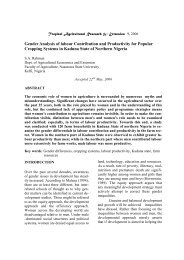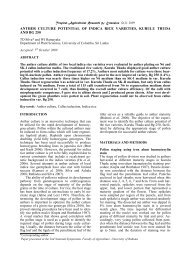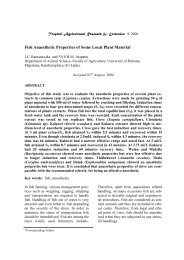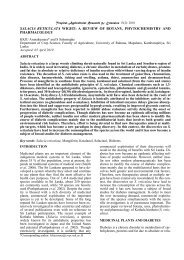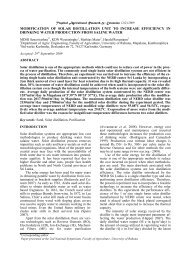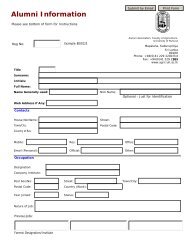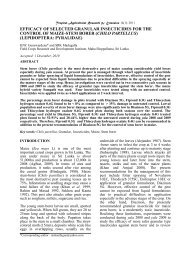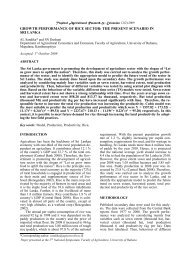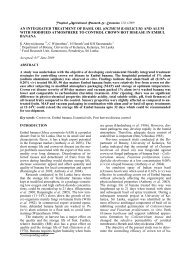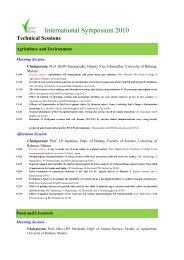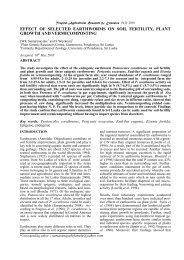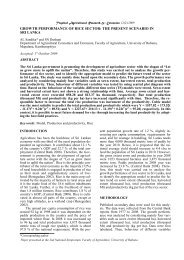Print this article - Sri Lanka Journals Online
Print this article - Sri Lanka Journals Online
Print this article - Sri Lanka Journals Online
You also want an ePaper? Increase the reach of your titles
YUMPU automatically turns print PDFs into web optimized ePapers that Google loves.
ABSTRACT<br />
Tropical Agricultural Research & Extension 10, 2007<br />
Effect of Culture Media for Anther Culture of Indica Rice Varieties and Hybrids<br />
of Indica and Japonica<br />
*1 H.M.I. Herath , 2 D.C. Bandara and 3 P.K. Samarajeewa<br />
1 Postgraduate Institute of Agriculture, University of Peradeniya, <strong>Sri</strong> <strong>Lanka</strong><br />
E-mail: indra_herath@yahoo.com<br />
2 Department of Agricultural Biology, Faculty of Agriculture, University of Peradeniya, <strong>Sri</strong> <strong>Lanka</strong><br />
3 Plant Genetic Resources Centre, Gannoruwa, Peradeniya, <strong>Sri</strong> <strong>Lanka</strong><br />
Accepted 5 th September 2007<br />
Pollen plants from anther culture in rice breeding allows selection of fine strains in early generations.<br />
Exploitation of anther culture technique in research is limited due to very low regeneration<br />
frequency of indica cultivars and the transfer of anther culture traits from japonica to<br />
indica varieties is important in improving these rice varieties. In <strong>this</strong> study the optimization of<br />
media requirements and culture conditions for high frequency callus induction and plant regeneration<br />
of several indica × japonica F1 hybrids were evaluated using improved anther culture<br />
media. Five indica rice varieties ( BG 90-2, BG 379-2, BG 94-1, Dahanala and Suduru<br />
samba) and two japonica varieties (Hu Lo Tao and Chuan 4) were selected and F1 hybrids<br />
were taken with all possible crosses between them. Panicles were cold pre treated at 5 o C for 7<br />
days and anthers were cultured in agar solidified modified N6, B5 and Millers media. Calli<br />
were transferred to MS medium for plant regeneration. Best callus induction frequencies (0.8 –<br />
29.4%) were obtained in N6 medium containing 5% (w/v) sucrose, than B5 (0.5 – 19.2%) and<br />
Millers (0.2 – 19.8%) media. The F1 hybrids were more responsive to anther culture than their<br />
parents. Highest callus induction frequency of 29.4% could observe in N6 medium for F1 hybrid<br />
Hu Lo Tao × BG 90-2. The green plant regeneration frequency of calli induced on N6 medium<br />
was higher than the other two media and the highest frequency of 41.0% was occurred in<br />
F1 hybrids of Hu Lo Tao × BG 90-2. Green plants were transferred to pots with 50 – 75% survival<br />
rate. Out of 99 plants survived, 28 plants had more than 5% spikelet fertility. Modified<br />
N6 medium had positive effect on anther culture performance and the F1 hybrid Hu Low Tao<br />
× Bg 90-2 had the best performance.<br />
Key words: anther culture, indica, japonica, modified media, plant regeneration, rice<br />
INTRODUCTION<br />
Anther culture as a method of creating haploid<br />
strains has become greatly useful in genetic<br />
studies and practical breeding (Yi, 1991). Double<br />
haploid systems have the unique genetic<br />
property of producing completely homozygous<br />
lines from heterozygous parents in a single<br />
generation (Snape, 1989). Using pollen parents<br />
from anther culture in rice breeding can reduce<br />
breeding time, increase selection efficiency and<br />
save space and labour in the field by allowing<br />
selection of fine strains in early generations<br />
(Shih-Wei and Zhi-Hong, 1991). This system<br />
provides an unparalleled opportunity to shorten<br />
the breeding cycle and fix agronomic traits in<br />
the homozygous state, such as recessive genes<br />
*Corresponding author<br />
for disease resistance (Datta, 2005). In a study<br />
conducted by Senadhira et al., (2002), in <strong>Sri</strong><br />
<strong>Lanka</strong>, they could identify salt tolerant anther<br />
culture derived rice lines within three years<br />
time.<br />
Rice has become one of the few crops in<br />
which anther culture can be rapidly applied in<br />
breeding programs (Chen et al., 1991). Extent<br />
of success of haploid induction depends on a<br />
number of factors that include genotype, developmental<br />
stage, cultivated conditions of plants,<br />
components of culture medium, pre treatments<br />
etc. (Shih-Wei and Zhi-Hong, 1991; Balachandran<br />
et al., 1999; Wang et al., 2000; Datta,<br />
2005).<br />
Exploitation of anther culture technique in<br />
breeding and genetics research is limited due to
18<br />
HMI HERATH ET AL.: ANTHER CULTURE OF INDICA AND INDICA × JAPONICA RICE<br />
very low regeneration frequency of anthers of<br />
rice in general, and indica cultivars in particular<br />
(Balachandran et al., 1999). As Zhang<br />
(1989) stated, there is relatively over dominance<br />
for culture ability and therefore making<br />
the cross combinations among the parents with<br />
different culture abilities can overcome the culture<br />
difficulties. Research efforts on the enhancement<br />
of response to anther culture have<br />
been confined mostly on manipulation of callus<br />
induction and plant regeneration protocols<br />
(Balachandran et al., 1999). According to<br />
Reddy et al. (1985), the application of N6 medium<br />
to indica rice was found to be limited although<br />
it is quite suitable for japonica rice.<br />
Therefore attempts were made to modify <strong>this</strong><br />
medium in order to improve its suitability.<br />
High yielding and traditional rice varieties<br />
grown in <strong>Sri</strong> <strong>Lanka</strong> belong to indica type and<br />
they respond poorly to anther culture. Transfer<br />
of anther culture traits from japonica to indica<br />
varieties is important in improving rice varieties.<br />
In <strong>this</strong> study the objective was to evaluate<br />
the response of anthers of selected indica (high<br />
yielding varieties and traditional varieties), japonica<br />
varieties and their inter sub specific F1<br />
hybrids for high frequency callus induction and<br />
plant regeneration in different culture media<br />
with certain modifications.<br />
MATERIALS AND METHODS<br />
Plant material<br />
Seeds of the two japonica and five indica rice<br />
varieties were collected from Plant Genetic Resources<br />
Centre, Gannoruwa, <strong>Sri</strong> <strong>Lanka</strong> (Table<br />
1). They were grown in pots in a greenhouse<br />
with providing standard agronomic conditions<br />
from June to November, 2002. The indica, and<br />
japonica varieties were crossed and F1 hybrids<br />
were produced in 2002. The parents and F1<br />
hybrids were grown in pots in the greenhouse<br />
from January to July, 2003.<br />
Anther culture<br />
First two to three panicles were collected from<br />
each genotype between 9.00 to 10.00 a.m. on<br />
sunny days when the distance between flag leaf<br />
and penultimate leaf was 5-7 cm. Anthers of<br />
uni-nucleate stage (microscopic observation)<br />
were obtained from the spikelets of middle part<br />
of the panicles. The panicles were wrapped in<br />
Table 1: A brief description of the parental<br />
rice varieties used<br />
Genotype<br />
Hu Lo Tao<br />
Chuan 4<br />
BG 90-2<br />
BG 379-2<br />
BG 94-1<br />
Dahanala<br />
Suduru Samba<br />
aluminium foil with moist cotton at the base of<br />
cut surface of the panicle and kept at 5 o C for 7<br />
days (Croughan, 1995) in sealed polyethylene<br />
bags.<br />
The panicles were rinsed with 70% (v/v)<br />
ethanol for 20 seconds. The spikelets were removed<br />
and they were surface sterilized with<br />
30% (v/v) commercial Clorox solution for 20<br />
minutes and rinsed thoroughly with sterilized<br />
distilled water. Anthers were removed from the<br />
spikelets and cultured 100 anthers in 100×15<br />
mm pettridishes with agar (Agar bacteriological<br />
No.1) solidified medium. The composition<br />
of the three callus induction medium used for<br />
anther culture establishment and plant regeneration<br />
medium is described in the Table 2.<br />
All the callus induction media were provided<br />
with kinetin 2.0 mg/l and 2,4-Dichlorophenoxy<br />
acetic acid (2,4-D) 1.0 mg/l and sucrose 5%<br />
(w/v). One pettridish constituted one replication<br />
and five replications for each genotype<br />
were cultured in each callus induction medium.<br />
The cultures were kept in the dark at 28 o C +<br />
2 o C (Chen et al., 1991) for callus induction.<br />
The cultures were examined weekly up to 6<br />
weeks and the callus induction frequency<br />
(percentage of anthers forming calli) was recorded<br />
on 6 th week.<br />
Plant regeneration<br />
Characteristics<br />
Japonica variety<br />
Japonica variety<br />
Indica, High yielding<br />
Indica, High yielding, resistant to Brown<br />
Planthopper and Bacterial Blight<br />
Indica, High yielding<br />
Indica, Traditional variety<br />
Indica, Traditional variety, good grain<br />
quality<br />
The calli of 1-2 mm diameter were transferred<br />
to 100×15 mm pettridishes containing 25 ml<br />
of half strength (both macro and micro nutrients)<br />
Murashige and Skoog medium (Murashige and<br />
Skoog, 1962) supplemented with kinetin 2.0<br />
mg/l and α-naphthaline acetic acid (NAA) 0.5<br />
mg/l (Croughan and Chu, 1991). The cultures<br />
were kept at constant white light (50 µE m -2 S -1 )<br />
for 16 h at 28 + 2 o C. The cultures were exam-
ined weekly and the data on percentage of calli<br />
regenerating green and/or albino plants was<br />
recorded after 6 weeks of incubation. The experiment<br />
was repeated for three times and the<br />
data shown are per experiment mean + standard<br />
deviation (Takeuchi et al., 1997).<br />
Shoots were transferred to half strength MS<br />
medium (supplemented with 0.5 mg/l NAA)<br />
for rooting. Regenerated plants were transferred<br />
to paddy soil in pots and grown to maturity<br />
in the green house. At maturity, spikelet<br />
fertility was measured as the ratio of number of<br />
grains per panicle to the total number of<br />
spikelets per panicle and expressed in percentage.<br />
All the experiments were set in Completely<br />
Randomized Design and data were analyzed by<br />
the Statistical Analysis System (SAS Release<br />
8.1) Analysis of Variance. Mean separation<br />
was done by Duncans’ Multiple Range Test.<br />
RESULTS AND DISCUSSION<br />
Effect of medium composition and genotype<br />
on callus induction<br />
In <strong>this</strong> study three different media (N6: Chu et<br />
al., 1975; B5: Gamborg et al., 1968; Miller:<br />
Miller, 1963) were used with some modifications<br />
based on the available literature for the<br />
callus induction. The major modifications<br />
made are shown in the Table 2. The sugar concentration<br />
of the media was increased to 5%<br />
(w/v) instead of 3% (w/v) in general media.<br />
Chaleff and Stolarz (1981) have recommended<br />
the concentrations of 4 – 5% (w/v) of sucrose<br />
for the callus growth and differentiation. According<br />
to Chen (1978), high sucrose concentrations<br />
have differential promotive effects on<br />
callus induction in anthers of different developmentalstages.<br />
All the media were provided with 2.0 mg/l<br />
2,4-D and 1.0 mg/l kinetin (Huang et al.,<br />
1986). In <strong>this</strong> study callus induction media was<br />
constituted with one half the level of NH 4<br />
+<br />
and<br />
double the level of KNO 3 nitrogen of basic N6,<br />
B5 and Millers medium (Chen et al., 1991).<br />
Callus induction started at three weeks of<br />
culture and the callus induction could be observed<br />
in both parents and F1 hybrids in all the<br />
media (Figure 1a). The frequency of callus formation<br />
varied between 0.2% to 29.4% depending<br />
on the genotype and culture medium (Table<br />
Tropical Agricultural Research & Extension 10, 2007<br />
3). Out of 17 genotypes evaluated, 12 responded<br />
better in N6 medium than B5 and<br />
Miller media. Callus induction frequency varied<br />
from 0.2 to 29.4% in N6 medium and 0.5 to<br />
19.2% and 0.2 to 19.8% in B5 and Miller media<br />
respectively. The indica varieties had high<br />
callus induction frequencies in B5 medium<br />
than the other two media ranging from 0.5 to<br />
9.4%. The anther response of Japonica and F1<br />
hybrids was quicker in N6 medium and formed<br />
visible callus after 3 – 4 weeks compared to 5 –<br />
6 weeks in the other two media. There was a<br />
significant genotypic effect on callus induction<br />
frequency among japonica, indica and F1 hybrids.<br />
Hu Lo Tao, Chuan 4 Japonica varieties<br />
and Hu Lo Tao × BG 90-2, Chuan 4 × BG 90-<br />
2 F1 hybrids had wide adaptation to different<br />
medium constituents. Both of these Japonica<br />
varieties and F1 hybrids had the highest callus<br />
induction frequency in all the three media. The<br />
indica varieties BG 379-2, BG 94-1, Dahanala<br />
and Suduru samba had the least anther culture<br />
response in all three media. However, BG 90-2<br />
variety had relatively high callus induction fre-<br />
Table 2: Composition of the modified media<br />
used for callus induction and plant<br />
regeneration.<br />
Component<br />
(mg/l)<br />
(NH 4 ) 2 SO 4<br />
NH 4 NO 3<br />
KNO 3<br />
Ca(NO 3 ) 2 .4H 2 O<br />
KH 2 PO 4<br />
MgSO 4 .7H 2 O<br />
CaCl 2 .2H 2 O<br />
H 3 BO 3<br />
MnSO 4 .4H 2 O<br />
ZnSO 4 .7H 2 O<br />
Na 2 MoO 4 .2H 2 O<br />
CuSO 4 .5H 2 O<br />
CoCl 2 .6H 2 O<br />
KI<br />
FeSO 4 .7H 2 O<br />
Na 2 EDTA<br />
Thiamine-HCl<br />
Nicotinic acid<br />
Pyridoxine-HCl<br />
Inositol<br />
Glycine<br />
Kinetin<br />
2,4 –D<br />
NAA<br />
19<br />
Callus induction media Plant regeneration<br />
N6 B5 Millers<br />
me-<br />
dium<br />
232 68 - -<br />
- - 500 1650<br />
3535 3125 2000 1900<br />
- - 1000 -<br />
400 - 300 170<br />
185 250 35 370<br />
166 150 - 440<br />
0.8 3 0.8 6.2<br />
4.4 - 4.4 22.3<br />
1.5 2 1.5 8.6<br />
- 0.25 - 0.25<br />
- 0.025 - 0.025<br />
- 0.025 - 0.025<br />
0.8 0.75 0.8 0.83<br />
27.85 - - 27.85<br />
37.25 - - 37.25<br />
1 10 0.1 0.1<br />
0.5 1 0.5 0.5<br />
0.5 1 0.1 0.5<br />
- 100 - 100<br />
2.0 - 2.0 2.0<br />
1.0 1.0 1.0 -<br />
2.0 2.0 2.0<br />
- - - 0.5<br />
Source (for basic me- dia): Gamborg and Phillips, 1998
20<br />
HMI HERATH ET AL.: ANTHER CULTURE OF INDICA AND INDICA × JAPONICA RICE<br />
Table 3: Effect of anther culture medium on<br />
callus induction from anthers of<br />
selected japonica, indica parental<br />
varieties and their F1 hybrids at 6<br />
weeks after inoculations<br />
Genotype<br />
Parents<br />
Hu Lo Tao<br />
Chuan 4<br />
BG 90-2<br />
BG 379-2<br />
BG 94-1<br />
Dahanala<br />
Suduru Samba<br />
F1 Hybrids<br />
Hu Lo Tao × BG 90-2<br />
Hu Lo Tao × BG 379-2<br />
Hu Lo Tao × BG 94-1<br />
Hu Lo Tao × Dahanala<br />
Hu Lo Tao × Suduru<br />
samba<br />
Chuan 4 × BG 90-2<br />
Chuan 4 × BG 379-2<br />
Chuan 4 × BG 94-1<br />
Chuan 4 × Dahanala<br />
Chuan 4 × Suduru samba<br />
Percentage + SD of calli formation<br />
N6 B5 Millers<br />
19.6 c + 0.5<br />
16.8 d + 3.2<br />
7.4 h + 1.8<br />
1.4 mn + 1.2<br />
0.8 no + 0.6<br />
0.4 o + 0.4<br />
0.2 o + 0.2<br />
29.4 a + 0.8<br />
8.4 g + 3.3<br />
4.7 i + 1.3<br />
3.2 lm + 1.9<br />
2.3 k + 1.5<br />
20.6 b + 2.5<br />
14.6 e + 1.5<br />
9.4 f + 2.4<br />
4.8 i + 1.9<br />
3.4 j + 2.0<br />
14.2 c + 1.8<br />
13.4 c + 3.2<br />
10.4 de + 2.7<br />
4.0 gh + 1.4<br />
2.4 hi +1.4<br />
1.4 hi + 1.0<br />
0.5 i + 0.4<br />
19.2 a + 1.4<br />
5.6 fg + 1.9<br />
2.2 hi + 0.8<br />
2.1 hi + 1.4<br />
4.4 gh + 1.1<br />
17.0 b + 1.5<br />
11.8 cd + 2.2<br />
7.8 ef + 1.9<br />
3.4 ghi + 2.0<br />
2.2 hi + 1.6<br />
11.0 c + 1.8<br />
13.6 c + 1.6<br />
6.6 e + 1.9<br />
0.4 j + 0.4<br />
0.2 j + 0.4<br />
0.2 j + 0.6<br />
0.2 j + 0.2<br />
19.8 a + 3.3<br />
5.2 f + 2.2<br />
2.2 gh + 1.9<br />
1.8 j + 1.3<br />
2.4 j + 1.5<br />
16.6 b + 2.7<br />
9.8 d + 1.9<br />
5.0 f + 2.5<br />
1.8 g + 1.3<br />
2.0 h + 2.1<br />
In a column, mean followed by the same letter are not significantly<br />
different at 5%<br />
quency than the other indica varieties. The F1<br />
hybrids Hu Lo Tao × BG 379-2, Hu Lo Tao ×<br />
BG 94-1, Hu Lo Tao × Dahanala, Hu Lo Tao ×<br />
Suduru samba, Chuan 4 × BG 379-2, Chuan 4<br />
× BG 94-1, Chuan 4 × Dahanala and Chuan 4<br />
× Suduru samba had intermediate anther culture<br />
response. This genotype dependency of the<br />
anther culture has been reported by Chen et al.<br />
(1991); Shih-Wei and Zhi-Hong (1992); Asad<br />
uzzaman, et al. (2003) in their previous studies.<br />
The time requirement for the callus initiation<br />
was also genotype dependent. Japonica<br />
varieties and F1 hybrids the callus initiation<br />
could observe at three weeks. The indica varieties<br />
tested had callus initiation at five weeks.<br />
Plant regeneration from anther derived calli<br />
The plant regeneration started after two weeks<br />
from transfer. Some calli differentiated only in<br />
to green plantlets (Figure 1b) or albino plantlets.<br />
Some calli differentiated in to both green<br />
and albino plantlets. The medium used for callus<br />
induction and the genotype of the donor<br />
greatly affected the frequency of green plant<br />
regeneration. Highest green plant regeneration<br />
could be observed in Hu Lo Tao × BG 90-2<br />
(19.2 – 29.2%) and Chuan 4 × BG 90-2 (17.7 –<br />
21.3%) F1 hybrids in all three callus induction<br />
media tested (Table 4). Also the performance<br />
of Hu Lo Tao × BG 379-2 and Chuan 4 × BG<br />
379-2 comparatively high. The green plant regeneration<br />
frequency from the calli initiated on<br />
N6 medium was higher than the other two media<br />
in all the varieties and F1 hybrids. The regeneration<br />
frequencies varied between 0-<br />
29.2% in the N6 medium while the B5 medium<br />
varied between 0-20.1% and the Millers medium<br />
varied between 0-19.2%. Among the parental<br />
rice varieties tested, Hu Lo Tao and<br />
Chuan 4 calli were more responsive for green<br />
plant regeneration.<br />
The frequency of albino plant regeneration<br />
from calli initiated on N6 medium and B5 medium<br />
was also high and the values varied between<br />
0-30.4% in N6 medium and 0-35.4% on<br />
B5 medium. Regeneration of albino plants has<br />
been reported as a major problem in rice anther<br />
culture especially in indica rice (Asaduzzaman,<br />
et al., 2003; Chen et al., 1991; Shi-Wei and Zhi<br />
-Hong, 1991). According to Roy and Mandal<br />
(2005), generally green plant regeneration from<br />
Table 4: Green and albino plant regeneration<br />
from anther derived calli (N6 medium)<br />
of selected japonica, indica<br />
rice varieties and their F1 hybrids<br />
Genotype<br />
Parents<br />
Hu Lo Tao<br />
Chuan 4<br />
BG 90-2<br />
BG 379-2<br />
BG 94-1<br />
Dahanala<br />
Suduru Samba<br />
F1 Hybrids<br />
Hu Lo Tao × BG 90-2<br />
Hu Lo Tao × BG 379-2<br />
Hu Lo Tao × BG 94-1<br />
Hu Lo Tao × Dahanala<br />
Hu Lo Tao × Suduru samba<br />
Chuan 4 × BG 90-2<br />
Chuan 4 × BG 379-2<br />
Chuan 4 × BG 94-1<br />
Chuan 4 × Dahanala<br />
Chuan 4 × Suduru samba<br />
Percentage calli regenerating<br />
shoots<br />
Green<br />
(G)<br />
Albino<br />
(A)<br />
G/ A<br />
22.5 b<br />
16.0 c<br />
1.0 ef<br />
-<br />
-<br />
-<br />
-<br />
41.0 a<br />
3.0 e<br />
-<br />
-<br />
-<br />
11.5 d<br />
1.0 ef<br />
-<br />
-<br />
-<br />
21.5 a 1.04<br />
19.0 a 0.84<br />
3.0 cd 0.33<br />
- -<br />
- -<br />
- -<br />
- -<br />
22.0 a 1.86<br />
10.0 b 0.3<br />
7.0 bc -<br />
1.0 cd -<br />
- -<br />
23.0 a 0.5<br />
18.0 a 0.3<br />
12.0 b -<br />
2.0 cd -<br />
2.0 cd -<br />
In a column, mean followed by the same letter are not signicantly<br />
different at 5%
Tropical Agricultural Research & Extension 10, 2007<br />
21<br />
Table 5: Transplanting survival, spikelet fertility of the anther derived indica, japonica varieties<br />
and their F1 hybrids<br />
Parents<br />
Hu Lo Tao<br />
Chuan 4<br />
BG 90-2<br />
Genotype Transplanting survival Spikelet fertility<br />
Plants transferred Plants survived Percentage survival 0 % 1-5 % > 5 %<br />
32<br />
24<br />
3<br />
a<br />
Figure 1: Callus induction and plant regeneration, a: magnified rice anther showing callus development<br />
at 6 weeks of culture, b: green rice plantlets developed from anther drived calli<br />
20<br />
18<br />
2<br />
62.5<br />
75.0<br />
66.6<br />
1<br />
3<br />
2<br />
4<br />
6<br />
-<br />
b<br />
15<br />
9<br />
-<br />
F1 Hybrids<br />
Hu Lo Tao × BG 90-2<br />
Hu Lo Tao × BG 379-2<br />
Chuan 4 × BG 90-2<br />
81<br />
4<br />
19<br />
43<br />
3<br />
13<br />
53.0<br />
75.0<br />
68.4<br />
21<br />
3<br />
8<br />
15<br />
-<br />
3<br />
2<br />
-<br />
2<br />
androgenic calli is very low and low anther<br />
culture response, high percent of albino plant<br />
regeneration are the principle constraints in<br />
establishing successful anther culture in rice.<br />
The green/ albino plant regeneration ratio<br />
of the Hu Lo Tao × BG 90-2 was high from the<br />
calli initiated on all the three callus induction<br />
media tested compared to all the other varieties<br />
and F1 hybrids tested. However <strong>this</strong> ratio of<br />
most of the genotypes remained low. As Shih-<br />
Wei and Zhi-Hong (1991) have stated, the frequency<br />
of albinism depend on the varieties or<br />
hybrids used, anther pre treatment temperature<br />
and the culture medium constituents.<br />
Transplanting and growing of anther derived<br />
plants<br />
Plantlets transplanted in to pots had 50-75%<br />
survival rate and they were grown to maturity<br />
(Table 5). The spikelet fertility varied considerably<br />
depending on the genotype. Out of 99<br />
the plants survived, 36 plants were completely<br />
sterile, 28 had 1-5% spikelet fertility and 28<br />
had > 5% spikelet fertility.<br />
Modified N6 medium has pleasing effect<br />
on the callus induction performance in indica ×<br />
japonica hybrids as well as japonica parents.<br />
The medium used for callus induction and the<br />
genotype greatly affects in the plant regeneration.<br />
REFERENCES<br />
Asaduzzaman, M. Bari, M.A. Rahman, M.H.<br />
Khatun, N., Islam, M.A. and Rahman, M.<br />
(2003) In-vitro plant regeneration Through<br />
anther culture of five rice varieties. <strong>Online</strong><br />
Journal of Biological Sciences: 3 (2): 167-<br />
171<br />
Balachandran, S.M., Sarma, N.P. and Siddique,<br />
E.A. (1999) Inheritance of anther culture<br />
response in rice. Current Science; 77 (7);<br />
962-964
22<br />
HMI HERATH ET AL.: ANTHER CULTURE OF INDICA AND INDICA × JAPONICA RICE<br />
Chaleff, R.S. and Stolarz, A. (1981) Factors<br />
influencing the frequency of callus formation<br />
among cultured rice (Oryza sativa) anthers.<br />
Physiol. Plant. 51: 201-206<br />
Chen, C.C., Tsay, H.S. and Huang, C.R. (1991)<br />
Factors affecting androgenesis in rice<br />
(Oryza sativa L.). In Biotechnology in Agriculture<br />
and Forestry: 14: Rice. Ed. Bajaj,<br />
Y.P.S. Springer Verlag. Berlin 193-211<br />
Chen, C.C. (1978) Effects of sucrose concentration<br />
in plant production in Anther culture<br />
in rice. Crop Sci. 18: 905-906<br />
Chu, C.C., Wang, C.S., Sun, C.S., Hsu, C.,<br />
Yin, K.C., Chu, C.Y. and Bi, F.Y. (1975)<br />
Establishment of an efficient medium for<br />
anther culture of rice through comparative<br />
experiments on the nitrogen sources. Science<br />
Sinica. 18: 659-668<br />
Croughan, T.P. (1995) Anther culture of doubled<br />
haploid production. In Plant Cell Tissue<br />
and Organ Culture. Eds. Gamborg,<br />
O.L. and Phillips, G. C. Narosa Publishing<br />
House. New Delhi. 143-154<br />
Croughan, T.P. and Chu, Q.R. (1991) Rice<br />
(Oryza sativa L.). Establishment of callus<br />
cultures and the regeneration of plants. In<br />
Biotechnology in Agriculture and Forestry:<br />
14: Rice. Ed. Bajaj, Y.P.S. Springer Verlag.<br />
Berlin. 19-37<br />
Datta, S.K. (2005) Androgenic haploids: Factors<br />
controlling development and its application<br />
in crop improvement. Current Science.<br />
89 (11): 1870-1878<br />
Gamborg, O.L., Miller, R.A. and Ojima, K.<br />
(1968) Nutrient requirements of suspension<br />
cultures of soybean root cells. Ex. Cell Res.<br />
50: 151-158<br />
Gamborg, O.L. and Phillips, G.C. (1998) Plant<br />
Cell Tissue and Organ Culture. Narosa<br />
Publishing House. London. 348<br />
Huang, C.R., Wu, Y.H. and Chen, C.C. (1986)<br />
Effects of plant growth substances on callus<br />
formation and plant regeneration in anther<br />
culture of rice. In Rice Genetics. Proc.<br />
of International Rice Genetics Symposium:<br />
IRRI; 763-771<br />
Miller, C.O. (1963) Kinetin and Kinetin like<br />
compounds. In Moderne der pflanzenanalyse.<br />
6: 194-202<br />
Murashige, T.P. and Skoog, F. (1962) A revised<br />
medium for rapid growth and bioassays<br />
with tobacco tissue culture. Physiol.<br />
Plant. 15 (3): 473-497<br />
Raina, S.K. and Zapata, F.J. (1997) Enhanced<br />
anther culture efficiency of indica rice<br />
(Oryza sativa L.) through modification of<br />
the culture media. Plant Breed. 116: 305-<br />
315<br />
Reddy, V.S. , Leelawathi, S. and Sen, S.K.<br />
(1985) Influence of genotype and culture<br />
medium on microspore callus induction and<br />
green plant regeneration in anthers of<br />
Oryza sativa. Physiol. Plant. 63: 309- 314<br />
Roy, B. and Mandal, A.B. (2005) Anther culture<br />
response in indica rice and variations<br />
in major agronomic characters among the<br />
androclones of a scented cultivar Karnal<br />
local. African Journal of Biotechnology. 4<br />
(3): 235-240<br />
Senadhira, D., Zapatha-Aris, F.J., Gregorio,<br />
G.B., Alejar, M.S., Cruz, H.C., Padolina,<br />
T.F. and Galvez, A.M., (2002) Development<br />
of the first salt-tolerant rice cultivar<br />
through indica/ indica anther culture. Field<br />
Crops Res. 76: 103-110<br />
Shih-Wei, L. and Zhi-Hong, X. (1992) Anther<br />
culture for rice improvement in China. In<br />
Biotechnology in Agriculture and Forestry:<br />
14: Rice. Ed. Bajaj, Y. P. S. Springer Verlag.<br />
Berlin. 19-37<br />
Snape, J.W. (1989) Doubled haploid breeding<br />
theoretical basis and practical applications.<br />
In Review of Advances in Plant Biotechnology.<br />
Eds. Kazi, A.M. and Stich, L.<br />
CIMMYT and IRRI. 19-30<br />
Takeuchi, Y., Abe, T. and Sasahara, T., (1997)<br />
Genetic analysis of plant regeneration from<br />
seed derived calli in rice (Oryza sativa L.).<br />
Crop Sci. 37: 963 - 965<br />
Wang, M., Sandra, V.B. and Bert, V.D. (2000)<br />
Insights in to a key developmental switch<br />
and its importance for efficient plant<br />
breeding. Plant Physiology. 124: 523-530<br />
Yi, F.P. (1991) Breeding new rice strains<br />
through anther culture. In Biotechnology<br />
in Agriculture and Forestry: 14: Rice. Ed.<br />
Bajaj, Y.P.S. Springer Verlag. Berlin. 116-<br />
129<br />
Zhang, Z.H. (1989) The practicability of anther<br />
culture breeding in Rice. In Review of Advances<br />
in Plant Biotechnology. Eds. Kazi,<br />
A.M. and Stich, L. CIMMYT and IRRI. 31<br />
-42



